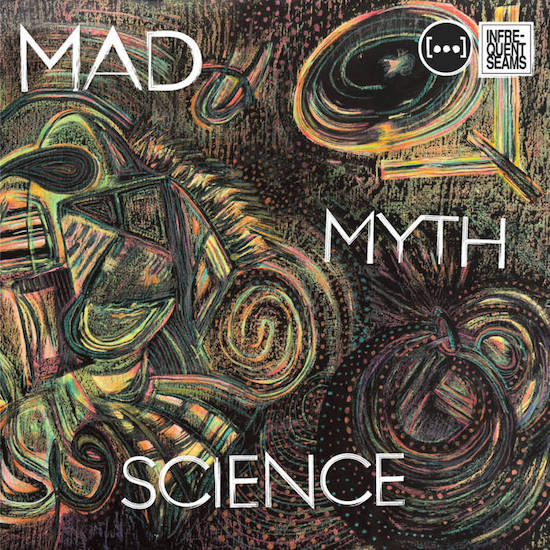For a brief moment early on in the pandemic, as the world collectively realised that social distancing and lockdowns were here to stay, we convinced ourselves that personal connections and artistic collaborations could be just as rewarding via video calls and other digital channels as they were in physically mediated spaces. In retrospect, it was nothing more than a myth perpetuated as a coping mechanism. While this remote mode of operation brought about some excellent works and unlikely collaborations, it also made it painfully obvious how some musics needed the networking influence of local scenes and comradely interactions to be able to fully flourish. Named after Sun Ra’s concept of myth-science and ideals of experimentation, Chicago’s Mad Myth Science project was conceived with its members isolated from each other, yet their self-titled debut is the result of a very immediate and visceral practice.
The music that Molly Jones (saxophone, flute, toys), Julian Otis (voice, electronics), Wilson Tanner Smith (cello, harmonica, bells, whistles), and Ben Zucker (cornet, vibraphone, percussion) make together is utterly Chicagoan, informed by the city’s rich creative music past and present. Moreover, the quartet’s eponymous debut captures an ongoing process and becomes a document of an evolving language shared between the ensemble’s members, all of them representatives of a new wave of Chicago’s experimental music scene. This rings true both metaphorically and literally, as the material that makes up the album’s six tracks contains outtakes from multiple lengthy sessions the group played at the recording studio and concert venue Experimental Sound Studio. As such, each of the cuts feels like its own distinct thing, a sonic world in miniature whose varied and stylistically fluid approach evokes the heritage of The Association for the Advancement of Creative Musicians (AACM), combining then mutating disparate strains of free jazz and improvisation.
On the aptly titled ‘We Instruments’, we first hear wild laughter, followed by Otis enunciating “wait, I’m sorry” with jester-like poise. His words morph into a solemn succession of clicking, mumbling, and humming, while his turns of phrase are shadowed by Jones’s revolving saxophone lines, Smith’s plucked strings, and Zucker’s lurching, pointillistic expressions on vibraphone. Soon enough, Otis’s voice grows into a controlled roar, ripping through registers and punctuating the piece. Here, as on the following five songs, the mutual camaraderie between players is palpable. In turn, their music feels born from personal understanding and grown through the sort of social osmosis that takes place when spending time together, something that no digital link can ever truly replace.
Later, ‘The World Spins On Its Axis’ turns things on their head, collapsing into a textural body of chimes, ardently bowed strings, and squeaking reeds, while a polyphonic singsong hangs above, repeating the piece’s title like mantra. Mad Myth Science then move from the scratchy instrumental loops and wild vocalisations on ‘When They See Us (Meditations)’ to a few steadier and more traditional sounding segments like the cello and flute dialogues found on ‘In The Weather Together’, the sustained melodies of ‘Nourishment’ and the spiritual jazz evoking chants of ‘Freedom Is A Feeling’, which wouldn’t feel out of place on Angel Bat Dawid record. And it’s here that, despite its daring avant explorations and abstract nature, Mad Myth Science ultimately reveals its fiery soul.


